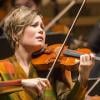
As it often does, San Francisco looked to the future over the weekend, with Music Director Designate Esa-Pekka Salonen ascending the podium at the San Francisco Symphony for three evenings. The program, packed with drama, felt especially positioned to offer the audience a deeper glimpse at their leader-to-be: At its heart was Salonen’s Violin Concerto, performed by the violinist for whom he wrote it and who has advocated for it so fervently since its 2009 premiere: Leila Josefowicz. Also included were Beethoven’s Overture to King Stephen and Nielsen’s Symphony No. 5.
San Francisco audiences know Salonen well. What better way to gain a sharper understanding of who the maestro is, where’s he’s been — and, perhaps, where he’ll take us — than through his Violin Concerto? Things came together sparklingly at the first concert Thursday evening. Many are excited for the San Francisco era of Salonen, framed as innovative and poised to connect the symphony hall with the 21st century.

Salonen composed the concerto at the end of his time as music director of the Los Angeles Philharmonic. The personal concerto is an apt introduction to how Salonen is carving out indelible marks on contemporary repertoire. While adhering to a four-movement structure, the concerto also breaks convention in its form, in ways a cultured tech city might especially admire. It’s “a kind of musical memoir,” as Alex Ross at The New Yorker wrote in his review years ago. Four movements, Ross said, trace a path telling the story of Salonen’s time from “solitary newcomer” to “a rich, long goodbye” by the final moment, titled “Adieu.” More than a decade after Salonen wrote it for Josefowicz, when he was departing a long-held post, San Francisco audiences heard it as he’s about to enter another. What does this do to our listening experience?
The work has no orchestra introduction, with the soloist immediately dancing about the fingerboard in the first movement, “Mirage.” Josefowicz’s articulation was sizzling and crisp as vibraphone and harp sprinkled in glassy utterances. Wearing an ensemble as ornately textured as the contemporary work, she wielded her bow arm like a painter’s knife, sailing through icy high notes and washy melodic fragments. She imbued crunchy, acerbic stabs with color. Her bond with the work — and her genuine love for it — shone through when the orchestra entered two minutes into the first movement. At the orchestra’s entrance — pooling in like a big fog wall of sound, a lush, violet dopamine cascade — Josefowicz seemed to turn toward the audience and acknowledge how grandly it flooded the hall. Her lips pursed with amusement and wonder, as if to wink at listeners and say, “I know, right?” Brisk double stops after the second orchestral tutti were especially piquant.

Josefowicz knows this work intimately (check out the 2012 recording with Salonen leading Josefowicz and the Finnish Symphony). The invigorating third movement, “Pulse II,” showed off the close bond between Salonen and soloist at its most electrifying. It’s an action-packed movement evoking a bustling urban stew, stippled with jazz and dance-band percussion. Hair and bow hair flying, Josefowicz whipped up into a storm, the violin line — with its determined, tenacious double stops and aggressive glissando skips — acting as lone voice in a cluttered, cosmopolitan landscape. Salonen has described the violinist as fearless, and this statement glowed in this movement, where Josefowicz seemed game for the zippy frenzy. The active and highly watchable percussion section here is another reason to witness a live performance of this concerto. (It’s a delight, really, to see a jazz drummer in a tailcoat.)
Salonen at the podium deftly stitched together soloist and orchestra. In the last movement, the violin bowed a high note as the orchestra unspooled a glimmering wave. Josefowicz emerged from it like a surfer duck diving, arching up, and breaking free.
The best moments of the concert were built on breaking convention. It closed with Nielsen’s Symphony No 5, composed in 1922. Sliced into two movements, it also provided moments of rapt drama. Principal Percussion Jacob Nissly was the turncoat solo snare drum who exited and reemerged later high above in the side terrace, unleashing a daring ostinato. As he walked offstage, drumming faintly as Salonen brought the orchestra steadily into a slow fade, it all seemed to echo the Violin Concerto’s final movement: “Adieu.”




